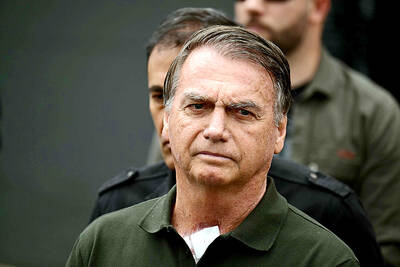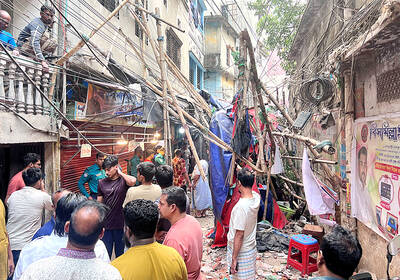More than 1,000 villagers in Inner Mongolia took the local Communist Party chief hostage Thursday in the latest land dispute to rock the Chinese countryside.
Amid signs of division in the government about how to handle rural unrest, the residents of Qianjin village have also driven off hundreds of armed police and blocked construction of a motorway they claim is being built through their crops and homes without adequate compensation.
"About 2,000 protesters have surrounded the local government office," a resident, who declined to give her name, told the reporters by telephone. "They are holding the general secretary and another official."
Another resident, a middle-aged man who gave his surname as Zhang, said this was the first time the village had been in conflict with the police.
"We only want our land and fairness," he said.
The villagers in one of China's poorest provinces say they had been paid only a fraction of the 9,900 yuan (US$1,200) they were promised for each of the 180 mu (about 667 square meters) of land requisitioned for the motorway.
In protest, they halted the work by occupying the building site and seizing construction equipment. Last week, they repelled more than 100 police who had been sent in to empty the site and arrest the ringleaders in a six-hour clash.
"The entire village is in a state of anarchy," Han Guowu, the district chief, told reporters. "Please trust the party and the government," he said. But such pleas are falling on deaf ears as more and more Chinese peasants take matters into their own hands.
The protest in Qianjin is at least the third since April in which locals have fought, and -- at least temporarily -- beaten public security forces.
In June, six peasants were killed in Shengyou, Hebei Province, during a battle with thugs employed by a power company to force them off their land. The government recognized the validity of their dispute, sacked the mayor and promised the villagers that they could keep their property.
Two months earlier, the residents of Huankantou, in Zhejiang Province, fought off more than 1,000 riot police during a protest over a chemical plant.
Countless other demonstrations go unreported. According to the Ta Kung-Pao, a Hong Kong newspaper funded by the government, 3.76 million people took part in 74,000 protests last year.
They are a symptom of China's growing pains as the one-party political system struggles to keep pace with a super-charged economy.
In many areas, public suspicions about official corruption have been rising along with personal expectations that are often left unfulfilled.
The government's response has been mixed. Earlier this month, vice-minister Chen Xiwen condoned the protests as a sign of growing "democratic awareness" among farmers.
In an ominous editorial yesterday, however, the People's Daily warned that any threat to stability would be crushed.
"Destabilizing factors must be resolved at the grassroots and nipped in the bud," the Communist Party organ said.

CHARGES: The former president, who maintains his innocence, was sentenced to 27 years and three months in prison for a failed coup bid, as well as an assassination plot Far-right former Brazilian president Jair Bolsonaro is running out of options to avoid prison, after judges on Friday rejected his appeal against a 27-year sentence for a botched coup bid. Bolsonaro lost the 2022 elections and was convicted in September for his efforts to prevent Brazlian President Luiz Inacio Lula da Silva from taking power after the polls. Prosecutors said the scheme — which included plans to assassinate Lula and a top Brazilian Supreme Court judge — failed only due to a lack of support from military top brass. A panel of Supreme Court judges weighing Bolsonaro’s appeal all voted to uphold

The latest batch from convicted sex offender Jeffrey Epstein’s e-mails illustrates the extraordinary scope of his contacts with powerful people, ranging from a top Trump adviser to Britain’s ex-prince Andrew. The US House of Representatives is expected to vote this week on trying to force release of evidence gathered on Epstein by law enforcement over the years — including the identities of the men suspected of participating in his alleged sex trafficking ring. However, a slew of e-mails released this week have already opened new windows to the extent of Epstein’s network. These include multiple references to US President Donald

DISASTER: The Bangladesh Meteorological Department recorded a magnitude 5.7 and tremors reached as far as Kolkata, India, more than 300km away from the epicenter A powerful earthquake struck Bangladesh yesterday outside the crowded capital, Dhaka, killing at least five people and injuring about a hundred, the government said. The magnitude 5.5 quake struck at 10:38am near Narsingdi, Bangladesh, about 33km from Dhaka, the US Geological Survey (USGS) said. The earthquake sparked fear and chaos with many in the Muslim-majority nation of 170 million people at home on their day off. AFP reporters in Dhaka said they saw people weeping in the streets while others appeared shocked. Bangladesh Interim Leader Muhammad Yunus expressed his “deep shock and sorrow over the news of casualties in various districts.” At least five people,

Chinese tech giant Alibaba yesterday denied it helps Beijing target the US, saying that a recent news report was “completely false.” The Financial Times yesterday reported that Alibaba “provides tech support for Chinese military ‘operations’ against [US] targets,” a White House memo provided to the newspaper showed. Alibaba hands customer data, including “IP addresses, WiFi information and payment records,” to Chinese authorities and the Chinese People’s Liberation Army, the report cited the memo as saying. The Financial Times said it could not independently verify the claims, adding that the White House believes the actions threaten US security. An Alibaba Group spokesperson said “the assertions